Related Research Articles
Animism is the belief that objects, places, and creatures all possess a distinct spiritual essence. Potentially, animism perceives all things—animals, plants, rocks, rivers, weather systems, human handiwork, and perhaps even words—as animated and alive. Animism is used in the anthropology of religion as a term for the belief system of many Indigenous peoples, especially in contrast to the relatively more recent development of organised religions. Animism focuses on the metaphysical universe, with specific focus on the concept of the immaterial soul.

Inuit religion is the shared spiritual beliefs and practices of the Inuit, an indigenous people from Alaska, Canada, and Greenland. Their religion shares many similarities with some Alaska Native religions. Traditional Inuit religious practices include animism and shamanism, in which spiritual healers mediate with spirits. Today many Inuit follow Christianity, but traditional Inuit spirituality continues as part of a living, oral tradition and part of contemporary Inuit society. Inuit who balance indigenous and Christian theology practice religious syncretism.
Finnish mythology is a commonly applied description of the folklore of Finnish paganism, of which a modern revival is practiced by a small percentage of the Finnish people. It has many features shared with Estonian and other Finnic mythologies, but also shares some similarities with neighbouring Baltic, Slavic and, to a lesser extent, Norse mythologies.
A joik or yoik is a traditional form of song in Sámi music performed by the Sámi people of Sapmi in Northern Europe. A performer of joik is called a joikaaja, a joiker or jojkare. Originally, joik referred to only one of several Sami singing styles, but in English the word is often used to refer to all types of traditional Sami singing. As an art form, each joik is meant to reflect or evoke a person, animal, or place..
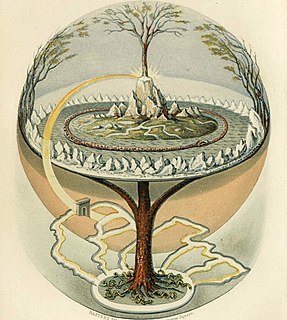
The world tree is a motif present in several religions and mythologies, particularly Indo-European religions, Siberian religions, and Native American religions. The world tree is represented as a colossal tree which supports the heavens, thereby connecting the heavens, the terrestrial world, and, through its roots, the underworld. It may also be strongly connected to the motif of the tree of life, but it is the source of wisdom of the ages.

Traditional Sámi spiritual practices and beliefs are based on a type of animism, polytheism, and what anthropologists may consider shamanism. The religious traditions can vary considerably from region to region within Sápmi.

A Sámi drum is a shamanic ceremonial drum used by the Sámi people of Northern Europe. Sámi ceremonial drums have two chiefly two variations, both oval-shaped: a bowl drum in which the drumhead is strapped over a burl, and a frame drum in which the drumhead stretches over a thin ring of bentwood. The drumhead is fashioned from reindeer hide.
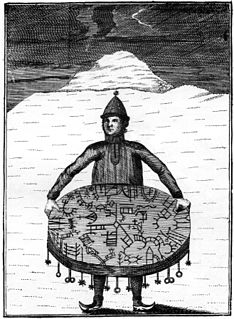
A noaidi is a shaman of the Sami people in the Nordic countries, playing a role in Sámi religious practices. Most noaidi practices died out during the 17th century, most likely because they resisted Christianization of the Sámi people and the king's authority. Their actions were referred to in courts as "magic" or "sorcery". Several Sámi shamanistic beliefs and practices were similar to those of some Siberian cultures.
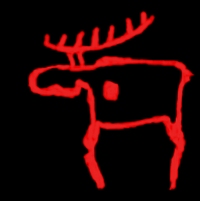
Finnish paganism is the indigenous pagan religion in Finland and Karelia prior to Christianisation. It was a polytheistic religion, worshipping a number of different deities. The principal god was the god of thunder and the sky, Ukko; other important gods included Jumo (Jumala), Ahti, and Tapio. Jumala was a sky god; today, the word "Jumala" refers to the Christian God. Ahti was a god of the sea, waters and fish. Tapio was the god of forests and hunting.
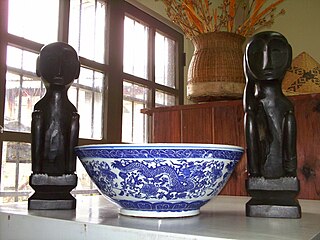
Indigenous Philippine folk religions are the distinct native religions of various ethnic groups in the Philippines, where most follow belief systems in line with animism. Generally, these indigenous folk religions are referred to as Anitism or Bathalism or the more modern and less Tagalog-centric Dayawism. Around 0.2% of the population of the Philippines were affiliated with the so-called "tribal religions", according to the 2010 national census.

Tengrism is an ancient ethnic and state Turko-Mongolic religion originating in the Eurasian steppes, based on folk shamanism, monotheistic at the imperial level, and generally centered around the titular sky god Tengri. The term also describes several contemporary Turko-Mongolic native religious movements and teachings. All modern adherents of "political" Tengrism are monotheists.

The traditional beliefs and practices of African people are highly diverse beliefs that include various ethnic religions. Generally, these traditions are oral rather than scriptural and passed down from one generation to another through folk tales, songs, and festivals, include belief in an amount of higher and lower gods, sometimes including a supreme creator or force, belief in spirits, veneration of the dead, use of magic and traditional African medicine. Most religions can be described as animistic with various polytheistic and pantheistic aspects. The role of humanity is generally seen as one of harmonizing nature with the supernatural.

Wiccan views of divinity are generally theistic, and revolve around a Goddess and a Horned God, thereby being generally dualistic. In traditional Wicca, as expressed in the writings of Gerald Gardner and Doreen Valiente, the emphasis is on the theme of divine gender polarity, and the God and Goddess are regarded as equal and opposite divine cosmic forces. In some newer forms of Wicca, such as feminist or Dianic Wicca, the Goddess is given primacy or even exclusivity. In some forms of traditional witchcraft that share a similar duotheistic theology, the Horned God is given precedence over the Goddess.
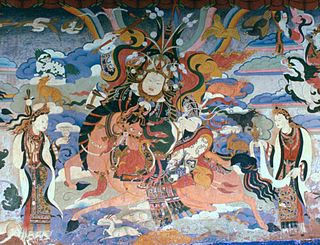
The Mongol mythology is the traditional religion of the Mongols.

In Old Norse, seiðr was a type of magic which was practised in Norse society during the Late Scandinavian Iron Age. The practice of seiðr is believed to be a form of magic which is related to both the telling and the shaping of the future. Connected to the Old Norse religion, its origins are largely unknown, and the practice of it gradually declined after the Christianization of Scandinavia. Accounts of seiðr later made it into sagas and other literary sources, while further evidence of it has been unearthed by archaeologists. Various scholars have debated the nature of seiðr, some of them have argued that it was shamanic in context, involving visionary journeys by its practitioners.

Bantu mythology is the system of beliefs and legends of the Bantu people of Africa. Although Bantu peoples account for several hundred different ethnic groups, there is a high degree of homogeneity in Bantu cultures and customs, just as in Bantu languages.
Nulgubjishin, also known as Nadgarishin is the deity of Nulgub, an area where grain are stored and ground into flour, in Korean mythology, as well as being the deity of grain. He is considered the weakest of the Gashin, the household deities of Korean mythology. There is thus no Gut nor Bonpuli dedicated to Nulgubjishin.

Kev Dab Kev Qhuas is the common ethnic religion of Miao peoples, best translated as the practice of spirituality. The religion is also called Hmongism by a Hmong American church established in 2012 to organize it among Hmong people in the United States.